|
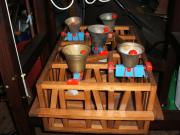
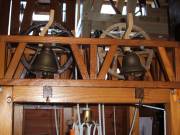
This image of 'White Wheel Doubles' shows the number three and two bells, the white wheel of the number two bell is visible on the right, this is how this model got its name.
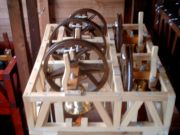
This is an old image of 'Doubles Ring' before the five bells were re-hung in a new frame and re-named 'White Wheel Doubles'. There was no white wheel in Doubles Ring but during the re-hang the number two bell had a new wheel made and that wheel was varnished white instead of Oak- the colour of the other wheels, hence the name 'White Wheel'.
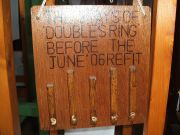
This wooden plaque was made during the conversion from Doubles Ring to White Wheel, it displays the old stays of Doubles Ring which were replaced with curved stays, it reads- 'THE STAYS OF 'DOUBLES RING' BEFORE THE JUNE '06 REFIT'.
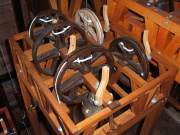
Another image of White Wheel, the treble is at the far end, with the tenor and number four hung facing the same direction, number two and three hang horizontal to the treble, tenor and number four.

A picture of 'Oakslider Doubles' with the bells in the inverted position, the tenor is the central bell with the treble on the left and the number four on the right. The bells are hung in the same way as with White Wheel but there is a difference by the fact that White Wheels bells are hung in a clockwise fashion, with the treble being to the left of the tenor while Oaksliders bells are hung anti-clockwise with the treble being to the right of the tenor.
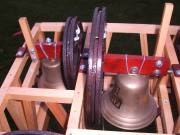
An image of Oaksliders treble (left) and tenor (right), the difference in size is plain to see, the bells are in the lowered or in the 'down' position.
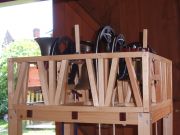
Oakslider, one of the bells is 'up' (far left) while the other four are 'down'.
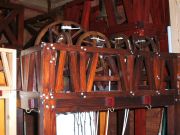
This picture of Monks Minor shows the bells in the 'down' fashion, the tenors wheel is much larger than the other wheels due to the tenor being larger than the other bells.
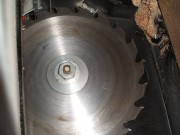
The circular blade of a table saw, such tools made cutting wood very fast but must be used with extreme care, if saws like this can cut through wood in seconds, they can also cut through fingers in seconds, care must be taken at all times.
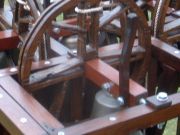
The number five bell of Monks Minor, noticably small than the number six or the 'tenor'.
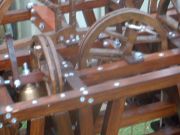
The number one or 'Treble' on the left with the second on the right, part of the tenors wheel and headstock can be seen behind these two bells.
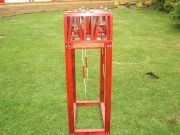
View of 'Minimus Four', this model contains four small Brass bells and stands about three feet tall.
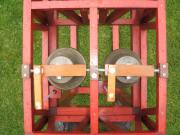
A partial birds-eye view of Minimus Four showing the number three and four bells- the chiming bars are clearly visible.
Another partial view of Minimus Four, this time showing the number one 'treble' and two bells, again, chiming bars are visible.
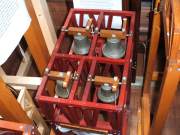
A whole birds-eye view of 'Minimus Four', taken at an angle, the bells are hung in a 'clockwise' fashion and the ropes hang down in a shape of a rectangle due to the shape of the frame.
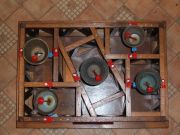
A view from above showing the layout of 'Bergholt Doubles', every care has been taken to reproduce this model to the ring of bells on which it is based, the tenor is in the center and the treble in on the top, right hand side, these bells are hung in a clockwise direction and are raised in the inverted position.
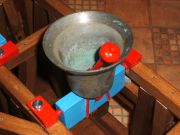
The 'treble' or smallest bell, these bells have no wheel, stay, slider or rope, just a headstock and gudgeons although there is a small block fixed to the framework underneath the bell which the headstock rests against to allow the bell to set inverted.
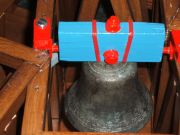
The 'tenor' or biggest, this time lowered, the headstock is blue and iron work red as on the bells at East Bergholt. Just visible between the headstock and left bearing cap is a grey block- the headstock rests against this to be set in the 'up' position.

Another view of Bergholt Doubles with the three and four bells nearest and the one and two at the back, the tenor or five is the central bell.
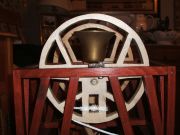
A side view of the Crossroad Bells in the raised position, the nearest bell is the lighter of the two with the other heavier bell behind, this frame has been double cross braced for added strength.
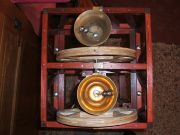
A birds eye view of Crossroad Bells again in the 'up' position the 15mm x 15mm stripwood frame is bolted onto a scaffold of 32mm x 32mm soft wood for more stabilty during ringing.
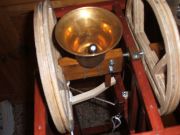
The above image is of the lighter bell of the Crossroad Bells, the wheel of the other bell is visible to the right.
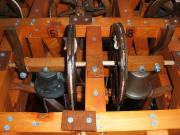
This is an image of the number six and number eight bells of Caters Campanile, the original wooden gudgeons are visible, later models had gudgeons of steel.
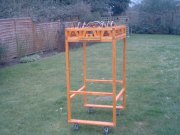
This early picture of Caters Campanile was taken just after being completed. When this picture was taken in Jan 2006 only two or three models existed, Doubles Ring, the next Mini Ring to be made is two months off and that would be re-framed and re-named 'White Wheel Doubles'.
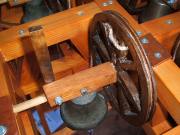
The Treble or number one bell of Caters Campanile complete with wooden gudgeons, this bell has been cracked sometime during its long life which has spoilt its sound.
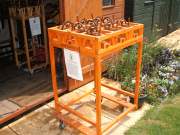
This image above shows Caters Campanile in its entirety, this model is the largest of all the Mini-Rings and also the oldest being completed on Christmas Day 2005, it was scrapped in 2010.
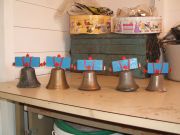
These bells belong to the Bergholt Doubles Mini-Ring having been removed from their frame. The tenor is on the far left and the treble is the opposite right with the numbers four, three and two in between.
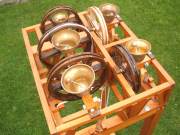
'White Wheel Doubles' above has 'Doubles' in its name bacause it contains five bells.
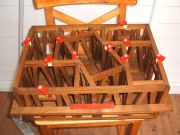
The empty frame of Bergholt Doubles above, as this frame has a plywood bottom (unlike any other model) dust and filth collects in the bottom of it and has to be occasionally cleaned out.
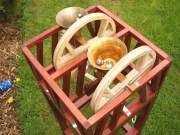
The 'Crossroad Bells' model is not named by how many bells the frame contains, the minimum number of bells a model can contain to be named by that number is three. |

Mini Ring Page
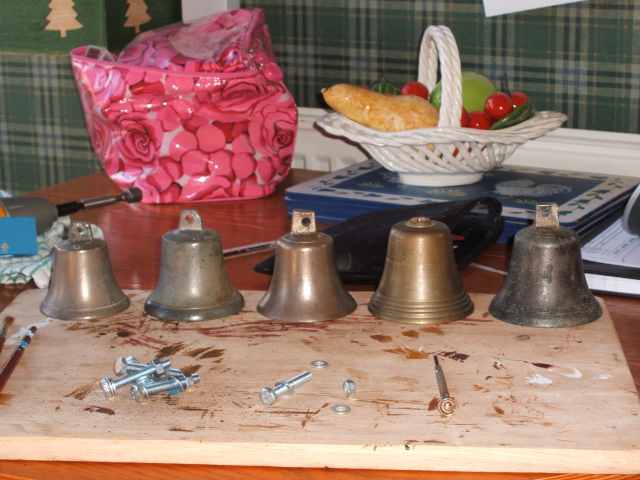
How a Mini Ring begins- it starts with just the bells.
IMPROVEMENTS
As from April 2010, Several of the Mini-Rings and Single Bell Frames have and are undergoing certain improvements, these include- Painting of Bolt heads, Nuts and Screws to replace the usual 'chrome' appearance and replacement of the old wire Cannon Straps with new softwood straps which improves the appearance of the models considerably.
SCRAPPING OF CATERS CAMPANILE
A 'Mini Ring' is a model which contains more than one bell.
'Monks Minor'
A six bell Mini Ring, Built between May-June 2006. Tenor: 1lb 9oz.
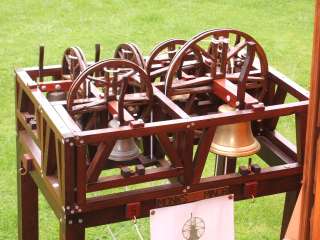
There are currently seven 'Mini Ring' models, containing between two and ten bells, However three of these Mini Rings each contains five bells, The other four contain two, four, six and ten bells.
White Wheel Doubles
This Mini Ring contains five very light bells, Weighing only 4-5 oz on average. The number two bell has a white coloured wheel, Giving rise to the name 'White Wheel'. This Model was originally named 'Doubles Ring' but the frame was re-built in May 2007 and re-named 'White Wheel Doubles'.
White Wheel Doubles
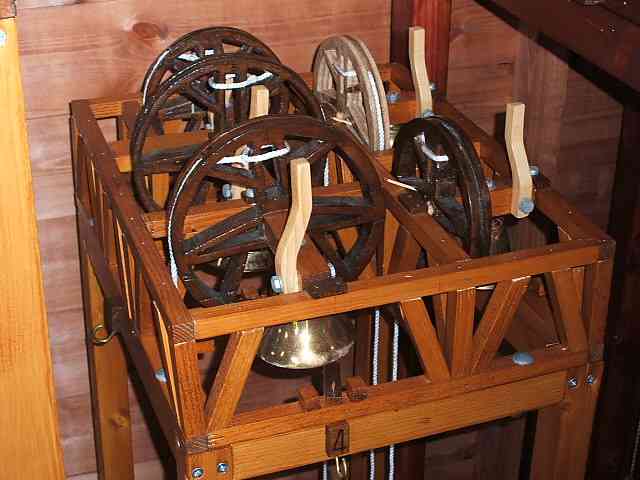
Oakslider Doubles
As with 'White Wheel Doubles', Oakslider contains five bells that are much heavier than White Wheels bells- the white wheel 'treble' or smallest bell only weighs around 4 oz while Oaksliders treble weighs about 11 oz and is heavier than White Wheels 'tenor'- the heaviest bell in a Mini Ring. This model was named as so because the frames sliders are made from Oak for added strength. This model was completed in June 2008.
Oakslider Doubles
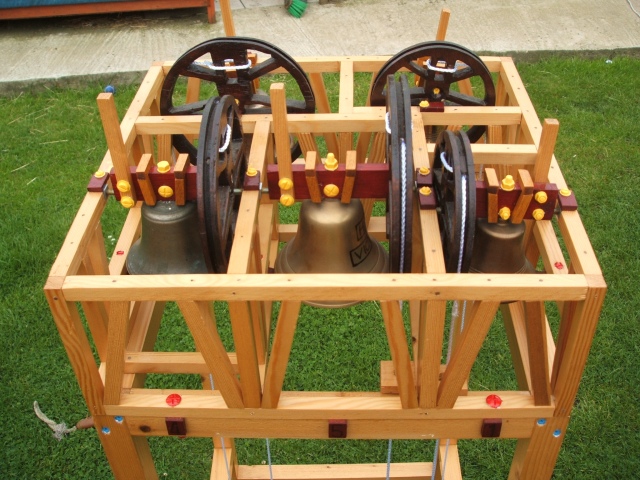
Monks Minor
This is only Mini Ring to contain six bells, and is the one of the oldest of the seven Mini Rings. There is a big difference in the size of the tenor compared with the other five, the frame had to be built tall enough to house this large tenor and extra beams had to be added for the smaller bells, these beams where for the sliders of the smaller bells, they had to be higher up in the frame for the stays to be able to reach them. This model took several weeks to complete and getting the right height for the slider beams proved to be a challenge, this model was made between May and June 2006.
Monks Minor

Minimus Four
Unlike all the other Mini Rings that have wheels, stays and sliders etc, this four bell Mini Ring houses bells which are only hung for 'swing chiming'- when a bell is only swung slightly from side to side in order to make it sound. The bell is attached to the headstock but instead of a wheel and stay added, a simple chiming bar is bolted on to one end of the headstock with the rope tied to the bars end. This is how bells are rung in nearly all other countries. The idea for this model came from the parish church of 'All Saints' Middle Claydon- a village in South Buckinghamshire, England. The Church is in the grounds of 'Claydon House', an estate owned by the 'Verney' family and managed by The National Trust. This model was built between September and October 2006.
Minimus Four

Swing-chime and full wheel- the differences
As we can see from above, swing-chime bells have a simple bar fixed to one end of the headstock while the bells in the other Mini Rings have a wheel and stay attached to their headstocks. With just a simple chiming bar, the bell feels alot more heavier than with a bell that has a wheel, this is because the wheel takes some of the bells weight when being rung, so for example a 1lb bell would feel much 'heavier' when chimed with a chiming bar than it would if it had a wheel- a wheel is many more times heavier than a simple wooden bar. A 12oz bell would feel heavier to ring if it were a swing-chime bell than a 1lb 12oz would if that were a bell with a wheel.
Bergholt Doubles
'Bergholt Doubles' is an altogether more unique model, it is the only model that has been built based on a real, full sized ring of church bells. There exists an unusual ring of five bells situated in the Suffolk village of East Bergholt, these bells are not high up in a church tower like other bells but hung in a small building or 'cage' situated in the churchyard, they must be the largest set of handbells in the world as they are not rung with a rope- ringers stand on a platform built around the frame and quite simply ring them with there own hands, though its not that simple- this ring of bells is the heaviest ring of five in the country with the tenor (heaviest bell) weighing 25 cwt or one and a quarter tons, thats 1250 kg- heavier than a small car!. Learning to ring these bells takes at least two years and can be very dangerous if not rung or taught by an experienced East Bergholt ringer, if one of these bells was to make contact with a persons body while in motion the effects could be fatal, in the same way as being hit by a slow moving car. These bells do set upside down with the headstock resting on a small stay and are left in the 'up' position when not be rung meaning the bell cage is always locked when the ringers are not practising. Ear defenders must be worn while ringing is in progress- these bells are very loud. This Mini Ring is a reproduction of those unusual bells but on slighty smaller scale!. This Model was named 'Doubles' because 'Doubles' is the name given to change ringing which is rung on five bells and was built in October 2007.
Bergholt Doubles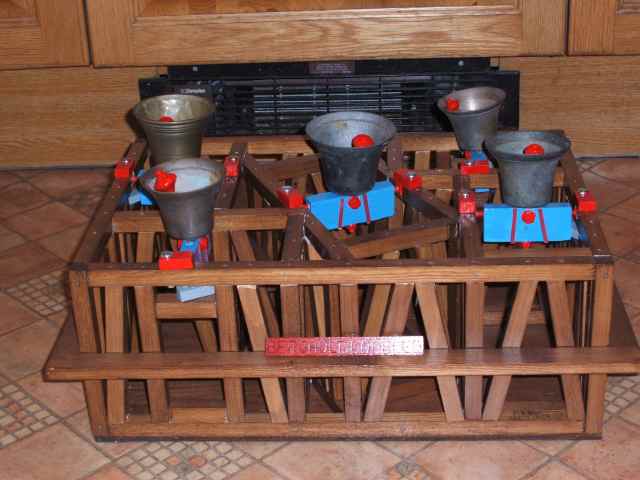
Crossroad Bells
This Mini Ring is the most recently constructed model, completed in April 2009 it contains the smallest number of bells in all the Mini Rings. This model was made as a demonstation of how bells are hung in a frame, almost like a cross section of a bigger model, in church bell frames a very large amount of force is created when the bells are in motion, a one ton bell will create four tons of sideways force, as a way of preventing this force doing the frame and tower a severe amount of damage, the bells swing in four different directions north, east, south and west to concentrate that force onto all sides of the frame which enables the frame and tower to cope with at least five bells ringing at once. The two bells in this model swing in an opposite direction to each other to demostrate how church bells ring in their frame.
Crossroad Bells
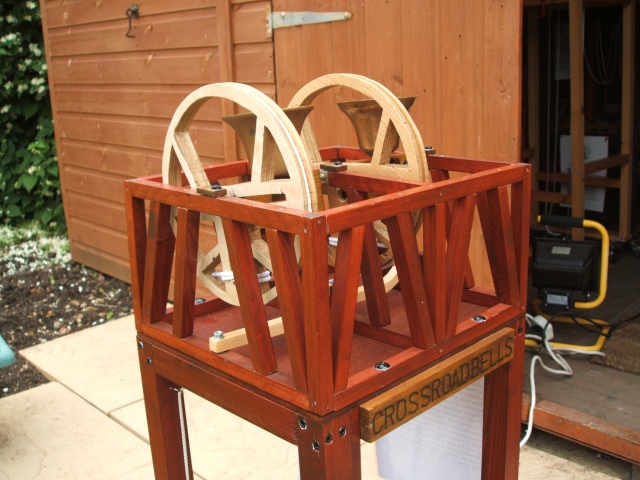
Caters Campanile
This was the very first Mini Ring to be built, it began as a model containing nine bells back in September 2005 but because this was the very first model built, it was somewhat crude in design compared to the more recent models as making models back in 2005 was very much an experimental art. Once the quality of workmanship improved over the next several months, a new frame was built to re-house these nine bells with a tenth being added, this frame was built to a better standard with improvements in varnishing, bolts being used instead of screws and all round improvements. The first frame was very much a prototype and as skills in frame and model design developed, much improved models where produced with the attention to detail on wheels being the best improvement. several of the early models dating from Sept 2005 to mid 2006 were completely re-fitted with new wheels, stays, sliders, ropes and had their original wooden dowel gudgeons replaced with gudgeons made of steel, although Caters Campanile still has its original wooden gudgeons in place. Caters Campanile is the largest of all the Mini Rings although the bells are fairly light compared to other Mini Rings like Oakslider Doubles whose Treble (lightest bell) is heavier than the Tenor (heaviest bell) in Caters Campanile.
Caters Campanile
2005-2010
In June 2010 it was decided that due to widespread technical advances in model bell making since the building of Caters Campanile in December 2005, Caters Campanile was dismantled with the ten bells being salvaged and the rest of the model e.g- frame, headstocks, wheels, ropes, stays and sliders being scrapped. The ten bells will be re-used in the construction of a much newer model or perhaps two or three different models in the future, the method of model making being so much improved since its construction. So future models will contain bells which were once hung together in Caters Campanile.
As Caters Campanile was the first successful Mini-Ring to be constructed, all the parts that were scrapped (everything except the bells) were burn't and the ashes were collected and scattered around the area where Caters Campanile was built. This old Mini-Ring has now become part of the fabric of where every existing model was built and where new models will continue to be made.
Change Ringing 'Names'
Three bells- Singles
Four bells- Minimus
Five bells- Doubles
Six bells- Minor
Seven bells- Triples
Eight bells- Major
Nine bells- Caters
Ten bells- Royal
Eleven bells- Cinques
Twelve bells- Maximus
As with a method of church bellringing is named by the number of bells its being rung on, the Mini-Rings also have the number of bells they contain in their name, for example 'Monks Minor' contains six bells so is named 'Minor', 'Minimus Four' contains four bells so has 'Minimus' in its name, 'Oakslider Doubles' is named as so because it has sliders made of oak and contains five bells, however 'Crossroad Bells' is named not because it has two bells- a method cannot be rung on just two bells so a specific name for two bells being rung does not exist.
|